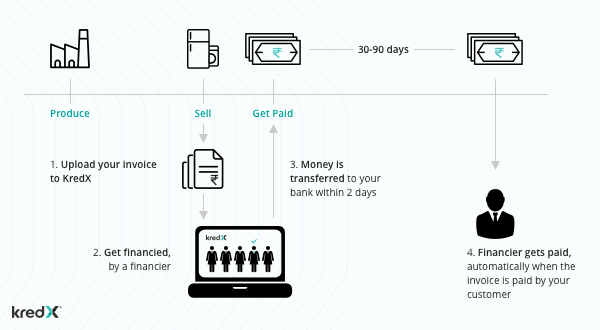Invoice Discounting
Most businesses provide credit facilities to their customers to boost sales and build brand loyalty. However, the issue arises when a significant amount of money is stuck in invoice receivables - impacting the working capital required to pay operating expenses. If credit is not given wisely, there will be a huge discrepancy between the cash inflow and outflow of the business.
Table Of Contents :
1) What Is Invoice Discounting?
2) Invoice Discounting Process
3) Advantages of Invoice Discounting
4) Disadvantages of Invoice Discounting
5) Invoice Discounting Interest Rates
6) Invoice Discounting Versus Business Loan
7) Difference Between Invoice Discounting and Invoice Discounting
Therefore, it is imperative for any business to make sure their working capital remains unaffected— even if it requires leveraging unpaid invoices through Invoice Discounting. Invoice Discounting service offered by KredX can help you access collateral-free, working capital to fuel your business requirements.
What Is Invoice Discounting?
It is a trade-related activity in which a company’s unpaid invoices which are due to be paid at a future date are sold to a financier (a bank or another financial institution).
In Invoice Discounting, the business trades the company's unpaid invoices to gain access to short-term financial assistance and maintain the working capital. It is mostly pertinent in cases when a buyer purchases goods from the seller, and the payment is made through a letter of credit. This process is also called “Invoice Discounting”. This process is governed by the negotiable instrument act, 1881.
Invoice Discounting Process:
KredX is a leading Invoice Discounting platform that allows businesses to trade their invoices digitally for quick access to short-term funds.

The Invoice Discounting process is transparent and simple. It includes the following steps:-
- Business generates an invoice (usually payable within 30 to 90 days) from the date of sale.
- Business visits the KredX website and uploads the unpaid invoice digitally.
- Investors in the KredX platform purchase the invoice at a discounted rate.
- The invoice value offered by the investor will be transferred to the business account within 24 to 72* hours upon approval.
- The business receives the funds and facilitates the working capital.
Advantages of Invoice Discounting:
Invoice Discounting is advantageous to businesses, banks, finance companies, and investors. Businesses benefit by rejuvenating their cash-flow in-turn helping them stabilise growth and fund business expenditure.
- Cash flow: Businesses being dependent on the cash flow to sustain their business can easily rely on this quick financial aid to access speedy funds and continue to flourish. This process quickens money inflow— profiting the organisation in expanding deals, seeking after development, securing hardware, etc.
- Instant access to cash: Invoice Discounting is a more efficient, faster way of assessing working capital as it is hassle-free and does not involve lengthy documentation procedure. With KredX, businesses can secure financial assistance in just 24 to 72* hours.
- No collateral involved: There is no requirement to keep any asset as security as the unpaid invoice is considered as the collateral itself.
- No debt incurred: Invoice Discounting helps in saving tax liability. The chances of a company suffering any loss or damage are almost nonexistent when compared to conventional financing frameworks.
- No impact on business sheet: Invoice Discounting service offered by KredX does not impact the balance sheet of the business as it is an off-the-book process.
Disadvantages of Invoice Discounting:
- Invoice discounting reduces the investor’s gross profit margin as the bank deducts a huge amount as a fee while discounting invoices.
- Most of the financial institutes discount only commercial invoices.
- It cannot be thought to be a long term solution for finance as is only a source of short-term fund arrangement.
- New businesses might not be eligible.
Invoice Discounting Interest Rates:
The interest rates are decided based on many factors such as the risk factor, the financial institute. The business will get a better rate if they choose a reputable platform. Invoice discounting interest rates are declining from the last two years and more MSMEs are availing aid rather than approaching for a loan.
Invoice Discounting Versus Business Loan:
|
Invoice Discounting |
Business loan |
|
Collateral-free finance |
Collateral required |
|
Quick processing (Usually in a couple of days) |
Long processing period |
|
Availed for short-term financial aid |
Availed for long-term financial assistance |
|
Digital process |
Generally not a digital process |
|
Hassle-free documentation process |
Lengthy documentation process |
|
Simple eligibility criteria |
Stringent eligibility requirements |
|
No impact on business balance sheet |
Impacts the business balance sheet and is considered as a debt |
Difference Between Invoice Discounting and Invoice Discounting:
The major difference between Invoice Discounting and invoice discounting is the loan tenure. Business can avail financial assistance for shorter tenure usually up to 90 days against unpaid invoices with invoice discounting. Whereas in Invoice Discounting, the tenure ranges from 30 to 120 days.
Eligibility Criteria:
- The business should be a minimum of 10 months old
- Should have dealt with at least 2 large-scale corporates
- Credit score should be 650 or more
- The business ought to have a base turnover of 25 lakhs
Documents Required:
The following documents mentioned are required to apply for Invoice Discounting in India:
Pre-assent Phase:
- KYC of applicant/co-applicant
- CIBIL record of directors
- Address proof and PAN Card copy
- GST registration certificate and returns
- Bank statement records 6/12 months
- Books of audited financials
- Loan Declaration
Post-asset Phase:
- Board Resolution
- Post-dated cheque
- Letter and Memorandum of Association
- A Guarantee letter
- Articles of association
Who Can Go For Invoice Discounting?
In a broader sense, small and medium-sized companies may find Invoice Discounting as an ideal way to boost liquidity. Businesses that are low on liquidity and lack immediate funding, often resort to Invoice Discounting to finance their purchase of raw materials and clearing off pending orders.
Other than these, businesses that intend to provide a more extended credit period to customers to sustain market competition can choose this funding option to keep operating activities continuous.
When Should We Go For Invoice Discounting?:
If at any time a business has to meet any of these following needs, they can fulfil the same by opting for Invoice Discounting –
To Boost Cash Flow
Invoice Discounting is a viable option to inject cash into the operational stream of a business. It helps entrepreneurs to replenish their cash flow and increase immediate liquidity quickly.
For Freeing Tied-Up Working Capital
This funding option allows businesses to free tied-up capital and in turn, eliminate the need of applying for a loan. Moreover, it also proves useful in shortening the working capital cycle.
To Settle Debts
If at any time businesses have to pay their suppliers, but their working capital is significantly low, they can get their invoices discounted. With the funds availed, they can pay their suppliers and other immediate liabilities.
Other than these, businesses can also get Invoice Discounting services if they need immediate funding but do not wish to provide any security to avail it.


